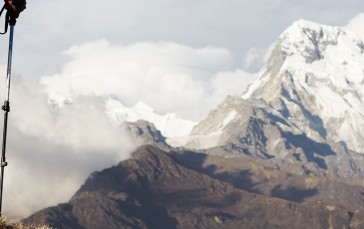High Altitude Hiking
You’ve well and truly got the hiking bug and decided that for your next big adventure it’s time to tackle your fear of heights and take on the dizzy altitude of some mountainous peak. The thought of the adrenaline pumping as you successfully scale and reach the summit is just too much for you to resist and after all, you already have all your essential camping and hiking gear including your favorite hiking shoes which are now well and truly broken in and the latest hiking watch that tells you all those vital statistics. You figure it’s time to pit your courage, your endurance and all your kit and caboodle against a more serious ascent. While you may well have invested in the correct equipment and already have downloaded all the latest hiking apps, have you invested in your fitness and training programme? Thought not! All the gear in the world is no substitute for a rigorous and effective training schedule. In case you are not really sure where to start, we have some top insider tips on how to Train for High Altitude Hiking which will have you bounding out of your camping tent to watch the sunrise at Annapurna base camp will a mountain goat.

Training for High Altitude Hiking
Testing your limits against a huge mountain-like Iliniza in Ecuador can’t just be done on a whim. It takes careful planning and preparation and not least requires you to be fit and able to hike in conditions where the air is thin, and your lungs will burn. Depending upon where in the world you currently reside, chances are you do your regular hiking and exercise much closer to sea level, so the physicality of the task and the lung capacity you will need to develop to complete your mission are going to be your biggest challenge. The rewards are so worth any amount of grueling training you might undertake as you might literally get to witness the natural environment from the top of the world.
What exactly is High Altitude Hiking
It’s commonly accepted that all routes which advance you above 8,000 feet (that’s 2,400 meters) are considered to be altitude hikes. The reason being that at 8,000 feet and beyond the human body begins to be affected by the principles of altitude. Reduced air pressure leads to less oxygen available to, and a decrease in oxygen causes the body to work less efficiently. Even if you have packed essential hydration packs, if you experience a sudden and rapid change in altitude too quickly, you can experience some severe side effects. That’s why you see base camps at strategic points on famous mountainous peaks so that climbers can ensure they fully acclimatize before progressing on to the next stage. High Altitude is not a race, it’s about endurance and for that you need to be fit in the correct you. You need to tap into something called your VO Max, and this is absolutely something you can train. Altitude can lead to all kinds of symptoms from sickness to headaches, loss of appetite and trouble sleeping so keep a careful track on how you are feeling and be aware of any symptoms like dizziness, temporary confusion and loss of circulation which are warning signs to slow things down.
The most important considerations when attempting a high altitude hike
Sounds obvious but take your time, do your climbing and your sleeping in manageable increments. Set yourself a good rhythm and slow your pace right down so that you take on board enough oxygen. Lots of deep and exaggerated breaths are needed to ensure you are regularly getting enough oxygen into your bloodstream. Plenty of water is essential to ensure that you are hydrated at all times to make sure that you have a plentiful water supply in the form of hydration packs and filtered water bottles. Alcohol is a big no-no. It dehydrates the body so when you are planning an Altitude Hike load up on the carbohydrates but stay clear of the wine until the weekend after you have successfully completed your ascent. Weather can change rapidly when you are hiking at higher levels and be unpredictable too so hiking apps are essential as are a good pair of water shoes for hiking. Invest in items of clothing that you can layer and that will trap in warm air to keep your warm and dry at all times, not sweaty, wet and damp. You are also going to want to ensure that besides those new hiking sunglasses and hiking gloves, you also pack the sunscreen. Remember that you get closer to the sun with each step so don’t forget the high factor sunscreen as the atmosphere can’t protect you in the same was, the higher you climb.

What about the physical training programme required
Ideally, you need to be starting with your High Altitude specific training at least two months in advance. This is even more important if your planned hike is going to take you above the 13,000 feet mark. Before you begin any new training programme, of course, no matter how fit and active you are generally, it’s always best to get the approval and sign off of a medical practitioner so that they can confirm that hiking at such altitude is recommended according to your age and current physical condition.
Get in as many regular hikes as possible beforehand
You really do need to be committed to hiking as regularly as you can in the run-up to carrying out a High Altitude hike, even if it’s not the first time that you have attempted one. The more frequently you can be hiking, the better for your body. If the option is open to you, try increasing on a weekly basis the altitude at which you do your regular hikes too as this will significantly help with your training and get your body more accustomed to functioning at these pending increased levels of altitude.
What other kinds of physical training are recommended
Interval training is going to be key. This is a method of dynamically training your cardiovascular system to better deal with prolonged endurance style activities. When you do interval training your entire system is challenged, and your heart rate elevated significantly for short bursts of time before its then punished (or should we say challenged) again. The quicker you recover in between these workouts, the stronger your cardiovascular system is becoming and the more capable you will be of dealing with exercising where there is less oxygen available to take on board. Great interval training activities include running sprints, hill sprints, and using an interval programme setting on a gym or home-based treadmill, exercise bike or cross trainer. You are trying to build up your stamina and your VO Max, so the point is to work really intensely and with lots of power and dynamism. Repetition and consistency are required. You need to attack your physical training programme with commitment and not skip any of the planned sessions. Run faster, for longer, on a steeper incline every week and try adding some weight to our back too to simulate the effect of hiking with a backpack. Many gyms, especially the higher end ones, have altitude training chambers. If you can find one of these that’s the perfect solution as they will put you into the correct environment to exercise, replicating what your body will have to endure on the hike day itself.

Work on developing a deep and rhythmic breathing system
Being able to control your breath is also vital. If you can master the art of conserving energy while at the same time expanding your overall breathing and lung capacity, this will put you in great stead when you are hiking at altitude and oxygen supplies are depleted. You need to learn how to breathe without overexerting yourself. You can check out lots of online resources that have useful information on how to develop breathing techniques specifically for hiking one of which is www.hikingdude.com. Get fit, practice your breathing technique and you are well on your way. There’s a Yoga breathing technique called The Alternate Nostril Breath which is also very effective and easy to master.
Get the Heart Pumping
Without a doubt, the most important thing when you are preparing for a High Altitude Hike is to regularly and routinely be getting your heart pumping. You should really aim to be engaged in active cardiovascular activity at least five days a week for a minimum of 30-60 minute sessions at a time. Start out your workouts at a moderate intensity so that you can breathe naturally, to begin with, and then increase your intensity incrementally over the days, weeks and months as you approach that hike. Cardio works the major muscles groups all in one go so in this respect it’s a useful form of exercise and time efficient. You get a lot of benefit from the one session. As we already mentioned, running (on a treadmill or outside), sprint interval training, stair-climbing, cycling, and the cross trainer are all great multi-tasking pieces of fitness equipment to help get your altitude ready.
Hit the weights and pump some iron
It’s also recommended that you incorporate strength training into our programme in preparation for a challenging hike. While the cardio exercise takes care of your heart, lungs, and legs, remember that when you are hiking you will have a heavy backpack, a camping tent no doubt, food and basic essentials to carry and unless you have Sherpa’s on the team, or Donkey’s laden up with all your kit, that honor rests very much on your own shoulders to make sure that you build up strength in your entire back and core area as well as your shoulders and arms. You don’t want to build up muscle mass like a body weight champion! Increased muscle mass could end up slowing you down unnecessarily, so you want to be strong rather than stacked. The aim is to develop all-round muscle strength, conditioning, stamina, and endurance so that you can manage to carry both yourself and your backpack at altitude. A good recommendation is that you pick out eight key exercises to target your arms, shoulders, chest, legs, glutes, and back and do at least 12-15 reps, with three sets in total, at a weight that is manageable but which does result in fatigue.

Move as much as you possibly can
Anytime, anyplace, anywhere! If there’s an option to take the stairs rather than the elevator, take it. If you can walk places, walk. At any given opportunity, commit to being on the move and active as part of your altitude training and your body will most definitely thank you for it when it comes to tackling the ascent itself. Train effectively, and it will seem like little more than a walk in the park rather than a high altitude hike.
Adopt a healthy eating lifestyle and fuel up in advance
We already mentioned the no alcohol rule but to be really sure of success, you should be adopting a healthy, clean eating and structured food programme for the immediate weeks prior to your hike to boost your overall energy levels and make sure that your muscles are being fed the right amount of quality nutrition. Poor eating habits can leave you lethargic so opt for plenty of nutrient-rich vegetables, lean proteins and plenty of fruits, nuts, and grains. A healthy eating regime, combined with all of that cardiovascular activity, will help you to drop a few crucial extra pounds too so that you are at a better weight to enjoy your hike to its maximum potential.
Follow these guidelines on how to Train for High Altitude Hiking, and you should be well on track to have an amazing and life-changing experience.









